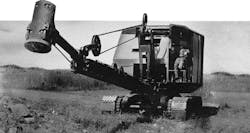Excavator Attachments Thru the 20th Century
During the era of steam power, the earliest excavators and cranes were purpose-built machines. You ordered a crane, a shovel, a dragline, a skimmer, or a primordial backhoe, and that was that.
As one might imagine, having to buy a new machine for dragline work while an expensive shovel gathered cobwebs in the yard did no favors for the owner’s bottom line. Although a machine might last longer due to not being used as much, lots of capital was tied up in idle iron, along with the expenses associated with owning, transporting, and operating two machines instead of one.
It wasn’t until the 1920s that manufacturers began to address this problem. The answer was to make excavators convertible, with booms for lifting, clamming, and dragline work being fully interchangeable with shovel, backhoe, and skimmer fronts. Unless a second machine was needed, the same basic machine could be kept busy with only the unused attachment sitting in the yard.
Concurrent with this, and likely helping drive it, was the emergence of small excavators from 3/8 through 1 cubic yard capacity. As these machines gained popularity in construction, it was only logical to make them as versatile as possible. However, not every attachment was offered with every model of excavator, and the largest cable excavators were rarely set up as backhoes. Moreover, different attachments and applications required different counterweighting and crawler lengths and widths for sake of machine stability.
During the 1960s and 1970s, hydraulic backhoes rendered cable backhoes and most construction draglines obsolete. Wheel loaders and hydraulic shovels did the same to cable-operated shovels. At least one firm, Northwest, marketed a machine that could be set up as a hydraulic backhoe or as a lattice crane; but the evolution of attachments for excavators moved in the direction of what became an astounding array of buckets, tools, and implements to attach to the backhoe stick.
The Historical Construction Equipment Association (HCEA) is a 501(c)3 nonprofit organization dedicated to preserving the history of the construction, dredging, and surface mining equipment industries. With over 3,800 members in twenty-five countries, our activities include publication of a quarterly educational magazine, Equipment Echoes, from which this article is adapted; operation of National Construction Equipment Museum and archives in Bowling Green, Ohio; and hosting an annual working exhibition of restored construction equipment. Our 2020 show will be August 28-30 near Concordia, Kansas. Individual memberships within the U.S. are $35 for one year, $66.95 for two years, and $99.95 for three years. We seek to develop relationships in the equipment manufacturing industry, and we offer a college scholarship for engineering and construction management students. Information is available at www.hcea.net, or by calling 419.352.5616 or emailing [email protected].





